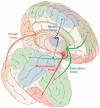A critical review of habit learning and the Basal Ganglia
- PMID: 21909324
- PMCID: PMC3163829
- DOI: 10.3389/fnsys.2011.00066
A critical review of habit learning and the Basal Ganglia
Abstract
The current paper briefly outlines the historical development of the concept of habit learning and discusses its relationship to the basal ganglia. Habit learning has been studied in many different fields of neuroscience using different species, tasks, and methodologies, and as a result it has taken on a wide range of definitions from these various perspectives. We identify five common but not universal, definitional features of habit learning: that it is inflexible, slow or incremental, unconscious, automatic, and insensitive to reinforcer devaluation. We critically evaluate for each of these how it has been defined, its utility for research in both humans and non-human animals, and the evidence that it serves as an accurate description of basal ganglia function. In conclusion, we propose a multi-faceted approach to habit learning and its relationship to the basal ganglia, emphasizing the need for formal definitions that will provide directions for future research.
Keywords: automaticity; basal ganglia; habit learning; reward.
Figures



Similar articles
-
The Aristotelian conception of habit and its contribution to human neuroscience.Front Hum Neurosci. 2014 Nov 3;8:883. doi: 10.3389/fnhum.2014.00883. eCollection 2014. Front Hum Neurosci. 2014. PMID: 25404908 Free PMC article.
-
Habit learning in Tourette syndrome: a translational neuroscience approach to a developmental psychopathology.Arch Gen Psychiatry. 2004 Dec;61(12):1259-68. doi: 10.1001/archpsyc.61.12.1259. Arch Gen Psychiatry. 2004. PMID: 15583117
-
Habit learning in hierarchical cortex-basal ganglia loops.Eur J Neurosci. 2020 Dec;52(12):4613-4638. doi: 10.1111/ejn.14730. Epub 2020 May 16. Eur J Neurosci. 2020. PMID: 32237250
-
Brain substrates for automatic retrieval of value memory in the primate basal ganglia.Mol Brain. 2021 Nov 16;14(1):168. doi: 10.1186/s13041-021-00871-x. Mol Brain. 2021. PMID: 34784931 Free PMC article. Review.
-
Where is my reward and how do I get it? Interaction between the hippocampus and the basal ganglia during spatial learning.J Physiol Paris. 2012 May-Aug;106(3-4):72-80. doi: 10.1016/j.jphysparis.2011.10.002. Epub 2011 Oct 19. J Physiol Paris. 2012. PMID: 22033208 Review.
Cited by
-
Learning and forgetting using reinforced Bayesian change detection.PLoS Comput Biol. 2019 Apr 17;15(4):e1006713. doi: 10.1371/journal.pcbi.1006713. eCollection 2019 Apr. PLoS Comput Biol. 2019. PMID: 30995214 Free PMC article.
-
Brain anatomy of the 4-day-old European rabbit.J Anat. 2018 May;232(5):747-767. doi: 10.1111/joa.12789. Epub 2018 Feb 14. J Anat. 2018. PMID: 29441579 Free PMC article.
-
When global rule reversal meets local task switching: The neural mechanisms of coordinated behavioral adaptation to instructed multi-level demand changes.Hum Brain Mapp. 2018 Feb;39(2):735-746. doi: 10.1002/hbm.23878. Epub 2017 Nov 2. Hum Brain Mapp. 2018. PMID: 29094788 Free PMC article.
-
Characterizing Human Habits in the Lab.Collabra Psychol. 2024 Feb 28;10(1):92949. doi: 10.1525/collabra.92949. Collabra Psychol. 2024. PMID: 38463460 Free PMC article.
-
The dynamics of functional brain network segregation in feedback-driven learning.Commun Biol. 2024 May 6;7(1):531. doi: 10.1038/s42003-024-06210-9. Commun Biol. 2024. PMID: 38710773 Free PMC article.
References
-
- Anderson J. R. (1982). Acquisition of cognitive skill. Psychol. Rev. 89, 369–406 10.1037/0033-295X.89.4.369 - DOI
Grants and funding
LinkOut - more resources
Full Text Sources

